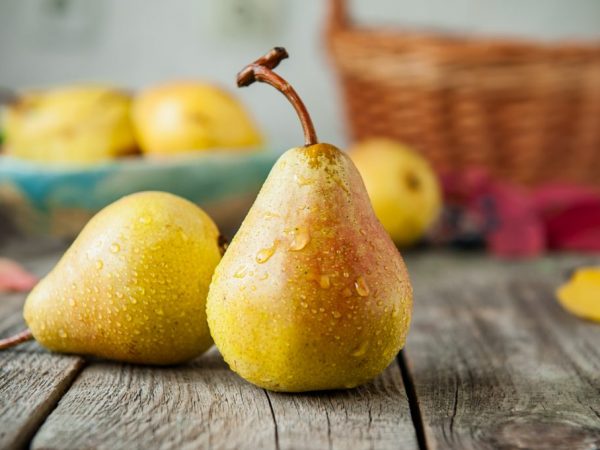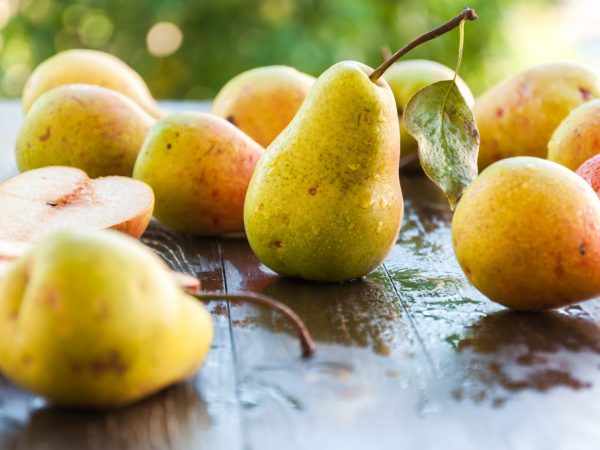Pribaltiyskaya oily pear
The high-yielding and winter-hardy Pribaltiyskaya oily pear ripens in the summer. With proper care and observance of the temperature regime, the fruits can be stored without losing their presentation for about two weeks. It is characterized by medium growth vigor.

Pribaltiyskaya oily pear
Variety characteristic
The sweet pear begins to bear fruit 5-6 years after planting, up to 60 kg every year. from the tree. The plant is planted both in autumn and spring. For culture, personal and garden plots are chosen. Baltic oily pear is actively used in folk medicine - in the fight against bronchitis, as well as in pharmacology in the production of certain medicines. Due to its good sweet taste and marketable appearance, the fruit belongs to the category of market varieties.
Ripening for early crop varieties occurs from mid-July to early September, depending on the growing region.
Description of the tree
Pribaltiyskaya oily is a medium-sized tree of about 2.5 m. According to the description, it has a strong root system and a fast-growing pyramidal crown. The branches of the tree are even, constantly raised up. The bark of the plant is gray or gray-green.
The shoots of an early pear variety grow dark brown. The leaves are smooth, with a short-pointed shape, and have a light green color. When blooming, the petals are oval, giving no aroma.
Description of fruits

Cute pears
According to the description, the fruits of the oily variety are attractive, with an average weight of up to 250g. Has a standard bottle shape. Fruit length about 10 cm, diameter 5 cm. When ripe, they do not crumble.
The color of the fruit is yellowish-green with a light orange color. The culture has smooth, thin skin. They have a tender, juicy, white pulp, semi-oily type. The Baltic pear has a sweet and sour taste.
Fruit application
The fruits of the oily pear are consumed both fresh and for cooking:
- jam;
- compote;
- marmalade;
- jam;
- wine or candied fruits.
Growing pears
Landing
The plant is undemanding to the soil, but it develops better on well-drained, fertile soils. Basic rules for planting the Pribaltiyskaya variety:
- Planting is carried out before the tree enters the active growing season. The optimal planting time is the end of March or mid-November.
- It is necessary to plant the plant in the most illuminated place, dry and even.
- The preparation of the seedling pit has been taking place since the fall. Standard sizes are chosen for her - 60x60 cm or 80x80 cm.
- The root system must be straightened before planting. Then place in a pit, sprinkle with earth, pour 10 liters of water and carefully tamp.
- Carry out appropriate agrotechnical measures - watering, hilling, feeding.
It is recommended to plant the Baltic oily in the southern regions only in the fall. For a neighborhood with other crops, apple trees are perfect.But the pear is not placed with mountain ash, they are susceptible to attacks by the same pests.
A two-year-old seedling is chosen for planting. The young shoot should be smooth, elastic and not dry. The standard seedling height is about 80 cm.
Plant care
With proper care, the tree gives a high yield and becomes more resistant to temperature extremes. Therefore, a number of agrotechnical measures should be performed.
| room | Agrotechnical event | Application |
| 1 | Watering | They are carried out from the first days of planting the plant to a permanent place in the garden. After planting, the plant must be watered with 10-20 liters of water. In summer, watered every 2 days with 1 bucket of water. During the cultivation period, 5 liters of water once a week. |
| 2 | Mulching | Choose an organic mulch: peat, humus, a layer of 8-9 cm. The seedling is insulated with spruce branches. |
| 3 | Pruning | The plant requires regular pruning in order not to grow upward, but to produce a large number of fruits. The procedure is done if the temperature is above -8 ° C. First, the crown of the tree is thinned out, after which the trunk is cut by a quarter. Pruning is carried out with a pruner or a garden saw. Lubricate the cuts well with garden pitch. |
The first years of cultivation are the most important, the tree requires appropriate feeding and abundant watering, taking into account weather forecasts.
Fertilizer
In a pit prepared for planting a seedling, it is necessary to add manure humus in the amount of 30 g, 400 g of sand and 100 g of potassium chloride.
The tree is treated in spring with a urea solution. To do this, mix 700 g of the substance and 10 liters of water. This will protect the crop from pests and introduce the required amount of nitrogen. Spraying with such a mixture should be carried out before the buds swell.
For prevention, drugs are used:
- Zircon;
- Ecoberin;
- Cymbush;
- Karbofos.
The first feeding is carried out in the spring before the beginning of the period of sap flow. The tree is fertilized with nitrate at the rate of 30 g per 1 m2. The second top dressing is applied in May. Use for such a solution of Nitroammofoski in a ratio of 1: 200 for 3 buckets of water. A mixture of 1 tbsp. Can also be a good fertilizer. l. potassium chloride, 2 tbsp. l. superphosphate and 10 liters. water.
Diseases
The main diseases that affect the culture:
- Black cancer. Appears on bark, leaves and branches as lesions and red in color.
- Fruit rot. The fruits turn brown.
- Scab. Symptoms are small spots on the leaves of a dark color.
- Mosaic disease. It appears as yellow and light green spots.
To combat diseases, it is necessary to remove or cut off diseased branches, leaves, fruits. And treat the tree with a solution of copper sulfate with the calculation of 50-100 g of substance per 10 liters of water.
Pests
Fruiting crops also suffer from pests:
- Leaf roll. To fight, use a decoction of chamomile or dandelion.
- Ticks. To get rid of them, use acaricides.
- Fruit moth. From her, spraying with Agravertine is used.
- Apple green aphid. A soap solution or infusion of mustard is used against it.
To combat insects and diseases, gardeners also recommend fungicides: Horus, Bordeaux liquid and Abiga-Peak. Or a solution containing 50 g of soda ash, 10 g of liquid soap and 10 liters of water.
Conclusion
The Baltic oily sweet pear, with the correct cultivation technology, brings not only fragrant fruits, but also a stable harvest. The likelihood of infection of a pear with any disease or pests increases if the planting agrotechnology was incorrectly carried out.


